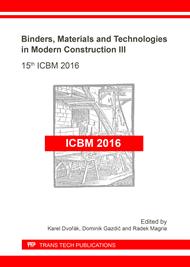p.83
p.88
p.94
p.100
p.106
p.111
p.118
p.123
p.129
Physico-Mechanical Properties of Lightweight Concrete with Fluidized Bed Combustion Fly Ash Based Light Weight Aggregate
Abstract:
Increasingly we see today among the conventional high temperature fly ash also with the production of fly ash from fluidized bed combustion. These fluidized bed combustions fly ashes, however, have little used this area, mainly for their chemical composition and morphology. Current efforts are directed towards the development of new technological processes and building materials that would allow the use of this industrial waste and its qualities. One possible way of fluidized bed combustion fly ash’s utilizing in construction industries the production of cold balled lightweight aggregate. Production of this material is economically advantageous and enables processing of large volumes of raw materials. This paper describes possibilities of using this aggregate for production of lightweight construction concrete and consequent testing of durability and resistance to various types of aggressive environment. For these lightweight structural concretes, will be verified in their thermal-technical parameters.
Info:
Periodical:
Pages:
106-110
Citation:
Online since:
October 2017
Authors:
Price:
Сopyright:
© 2017 Trans Tech Publications Ltd. All Rights Reserved
Share:
Citation:


